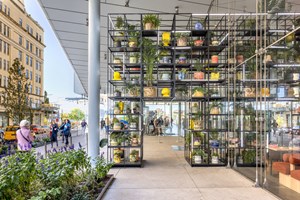
As part of the Whitney’s reimagined food and beverage program—which aims to create welcoming, approachable spaces for people to gather, connect, and recharge—Frenchette Bakery, which opened in TriBeCa in 2020, will open a new flagship location, with its first-ever cafe in the Museum’s redesigned ground-floor restaurant space in November 2023.
Frenchette Bakery’s second, significantly expanded location incorporates a cafe element and will first offer take-away breakfast, lunch, and on-premises baked sweet and savory fare, with plans to add sit-down dining options for breakfast and lunch later this year.
In addition to the ground-floor restaurant, the Whitney is working with the team behind Frenchette on a new concept for the Museum’s eighth-floor cafe space, which operated as Studio Bar. The new eighth-floor space will open in 2024; Studio Bar closed on October 16 for construction to begin.
To connect the restaurant spaces with the Museum’s mission to celebrate and support contemporary art and artists, both spaces will be anchored by significant, newly commissioned artworks. The ground floor will feature an installation by artist Rashid Johnson, and the eighth-floor space will showcase a work by artist Dyani White Hawk.
Both dining spaces are being designed by New York City–based architectural firm Modellus Novus.
“The bakery and cafe will be a welcoming, approachable neighborhood destination and gathering space open to Museum visitors and non-visitors alike,” said Amy Roth, co-chief operating officer at the Whitney Museum. “Anyone can stop by for baked goods, coffee, or a snack to enjoy on the Whitney's steps, the nearby High Line, or Hudson River Park, or linger and recharge over a meal. There will be something for everyone. We are proud to bring this exciting new addition to the community and to the Museum. We have the ideal partner in the Frenchette team—whose philosophies and mission are aligned with ours—to help forge new connections between the Whitney and the neighborhood.”
“As long-time New Yorkers, we have always loved the energy and history of the neighborhood and are excited to become a more permanent part of it with our new bakery and cafe inside the Whitney,” said Lee Hanson and Riad Nasr, Chef/Owners of Frenchette.
At the center of the new Frenchette Bakery and cafe will be the sprawling indoor-outdoor installation New Poetry by artist Rashid Johnson, whose work is in the Whitney’s collection and has been featured in several recent exhibitions, including America Is Hard to See and An Incomplete History of Protest: Selections from the Whitney’s Collection, 1940–2017.
Johnson’s sculpture—a new addition to the Whitney’s permanent collection—helps create an immediate connection between the Museum, the community, the new space, and visitors. A massive black steel sculpture with shelves holding books, ceramics, monitors playing films, lights, plants, and more, the piece expands through the interior space and past the walls of the restaurant to also inhabit the exterior space in front of the Museum, allowing all passing by to see and walk through it. According to Johnson, “the steel grid works are multifaceted. They work as a brain, delivering disparate materials and information into one location where conceptual connections and new ways of thinking come from their physical proximity.” Experiencing the work—which features plants to create a more intimate connection, and books of poetry to nod to the medium’s importance in Johnson’s life—is an opportunity for visitors to “look at the way I think but also allow space for the interior lives and personal experiences of the viewer.”
“Poetry is a vehicle for the exploration of critical concerns, aesthetics, and the romantic,” said Rashid Johnson. “It is a mode that acts as a mirror of all other mediums. I consider this sculpture to be a poem.”
The eighth-floor space will incorporate a new installation by artist Dyani White Hawk, whose work is in the Whitney’s collection and was featured in Whitney Biennial 2022: Quiet as It’s Kept.
White Hawk’s new installation Nourish combines influences from her Wopila | Lineage series, first created for the 2022 Whitney Biennial, and her ongoing Quiet Strength series. Both bodies of work honor legacies of Indigenous art by centering the original practices of abstraction on this continent, and calling out the lack of representation of Indigenous history and contemporary peoples in national narratives. White Hawk’s work encourages critical thinking on how we choose to tell our stories as nations, institutions, and communities—advocating that through sharing the full and complicated truths of our shared histories, we increase opportunities for compassion and healing, necessary building blocks for a healthier future. Nourish introduces new exploration in ceramic tile for the artist (in part as a nod to NYC subway tiles). The ceramic tiles are handmade and fabricated by Mercury Mosaics (Minneapolis, MN). The composition is rooted in Lakota abstraction incorporating symbolism that embodies themes of balance, connection, and honoring connectivity across life and land.
“I am honored and grateful to create work that will contribute to the beauty of a space in which people will gather, share sustenance and ideas, build and nurture relationships, or take the time needed to rest, reflect, and recharge. This is especially important in a museum when we are experiencing tremendous amounts of sensory input and deeply charged human expression.” said Dyani White Hawk. “When cared for intentionally, the spaces in which we share meals together, and/or find respite, can be the most sacred of spaces—where we take part in nourishing mind, body, and spirit, gathered together, or individually among the company of others. I pray that this work enriches the experience of all those that gather here, feeding and soothing people’s minds, hearts and bodies. I pray that the work nurtures, inspires, warms, and welcomes all.”
For the design of both dining spaces, Modellus Novus has applied its expertise in projects that warmly welcome the public to enjoy dynamic cultural and dining experiences, having most recently designed Lincoln Center’s celebrated restaurant Tatiana. The firm’s aim was to blur interior and exterior to help create connections between diners and their surrounding community, as well as maintain the original open concept of the Museum’s design by architect Renzo Piano. The architects worked closely with the artists to ensure the open, friendly, and welcoming spaces are fitting for the artworks being created and supportive of dialogue around those works.
“For both the museum’s ground-floor and eighth-floor dining spaces, our aim is to create holistic, unified environments that center the artists and their work while offering guests serene spaces to enjoy the museum’s enriched culinary offerings,” said Jonathan Garnett, Partner/Creative Director, Modellus Novus. “It’s been a privilege to collaborate closely with Rashid Johnson and Dyani White Hawk throughout every step of the design process to ensure the new spaces seamlessly integrate art and architecture, as well as celebrate the museum’s intent to welcome the public through remarkable transparency and clear sight lines to the Hudson River and city views beyond.”

ArtDependence Magazine is an international magazine covering all spheres of contemporary art, as well as modern and classical art.
ArtDependence features the latest art news, highlighting interviews with today’s most influential artists, galleries, curators, collectors, fair directors and individuals at the axis of the arts.
The magazine also covers series of articles and reviews on critical art events, new publications and other foremost happenings in the art world.
If you would like to submit events or editorial content to ArtDependence Magazine, please feel free to reach the magazine via the contact page.